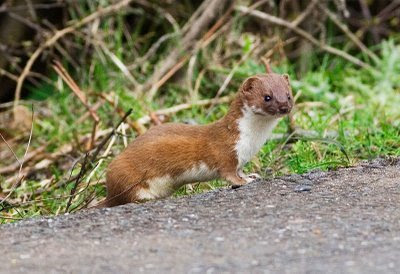 |
| Ermine |
So common were the reports that we put a request for sightings out and the response was excellent with over seventy records from as far as the river Tweed in the north to Teesdale in the south such was the extent of the reports. A big thank you to all that contributed their records we have added them to the regional record centre and it this that has prompted this article on our two, well lets say ‘lesser known’ members of the mustelid clan.
We often over look these two smart little gentlemen in their chestnut livery in favour of their more charismatic family members the otter, pine marten or badger. They also suffer a truly unfair image of skulduggery and slyness or as a wanton killer of poultry and game. None of these are really true in general terms but give a critter a bad name and it sticks.
The stoat occurs throughout Britain and Ireland, living in a wide variety of habitats and at any altitude with sufficient ground cover and food. A stoat does not like to be out in the open and as such they hunt along ditches, hedgerows, walls and through meadows and marshes. They are systematic hunters quartering the ground and all but the largest of prey is summarily dispatched by a single bite to the back of the neck.
 |
| Weasel by the road |
The weasel on the other hand is much more widespread throughout Britain but absent from Ireland and many off shore islands. It is probably our most numerous carnivore. They found over wide range of habitats like the stoat but including urban areas, where they are very handy to have around if you have a mouse problem like I have had over the winter.
The weasel specialises in hunting small tunnel living prey such as voles and mice, the weasels small size means it can hunt them both above and below ground and hunt in both day and night. They do not hibernate and hunt under the snow. Like its cousin the stoat it will often take over the dens of its prey and they will have several with their range. I’ve had a weasel take up residence for the last two winters in my compost heaps for which I am very grateful as the numbers of small brown rodents increase exponentially with the winter months around my chicken’s dinner. When the weasel turns up they rapidly decline. I removed one of my compost heap recently and revealed the said den complete with mummified food reserves stored by the now absent mustelid.
Although they look similar cosmetically (I will refrain from the weasely similar jokes), their ecology is quite different especially in the breeding stakes. Both sexes live separate lives only coming together to mate. Stoat and weasel home ranges vary a lot depending on the distribution and density of prey. Resident animals may defend their territories when numbers are high and neighbours numerous but in the spring these systems break down as males of both species prospect widely for females.
 |
| Baby weasels grapple in the grit |
Weasels only produce one litter a year sometime two if there are plenty of field voles about. 4-6 youngsters are born and are weaned at 3-4 weeks; they can kill efficiently at 8 weeks and split from the family group between 9-12 weeks. In a good vole year females can be pregnant at 2-3 months old.
Stoats on the other hand use a completely different breeding strategy than mass reproduction. Males mate with females, including this years kits, which may be only 2-3 weeks old, in the early summer. They do not give birth however until the following spring because implantation is delayed for 9-10 months by that time females may have dispersed a considerable distance from where they were actually born.
Stoats also have quite large litters, like weasels to compensate for high mortality rates, between 6-12 young are born, blind, deaf and bald. The female feeds them for up to 12 weeks by which time they are efficient hunters able to take out a half grown rabbit.
 |
| How cute can anything be, a baby stoat well on the way to being a stone wall killer |
Food shortages is the main killer of young stoats and weasels, the trap is barely effective in control and both species occasional fall prey to hawks, owls, foxes, mink and even cats. There is little competition between the two as the stoat is larger and much more aggressive it takes larger prey like rabbits whilst its smaller cousin is an out an out ‘tunnel hunter’ reaching small rodents the stoat cannot.
They are both remarkable creatures both in looks and habits I never tire of seeing them, that fleeting glimpse as a weasel scurries across the road in front of your or watch a stoat chase and run down a rabbit like a cheetah on a gazelle is astounding to witness. The loss of a few game birds and or chickens is nothing compared to the overall good these animals do in the environment. The pleasure they give is uncountable, if encounter one try ‘squeaking’ through pursed lips like a mouse or rabbit, and you may be treated to an encounter you will never forget especially if it is a family party dancing around your feet, truly remarkable creature that deserve more respect than they get.
I saw one of these all white in the snow located in Pioneer California yesterday. I had never seen one before and until these pictures I did not know what it was. My buddy called it a "An artic lemar" LOL !!
ReplyDeleteThank you for such an interesting read. I will be on the lookout for stoats and weasels for sure when I'm in their habitats.
ReplyDelete